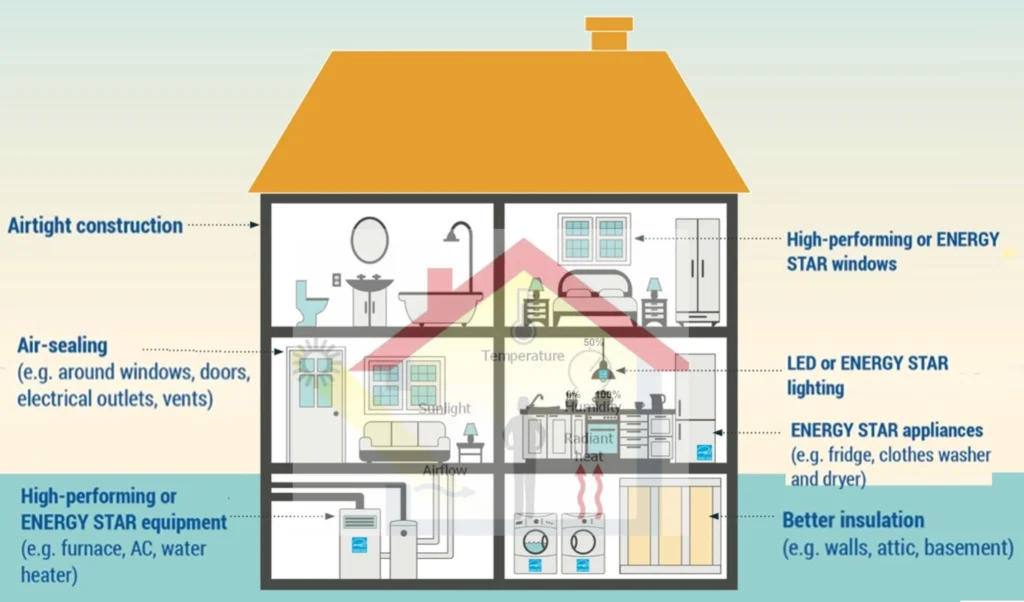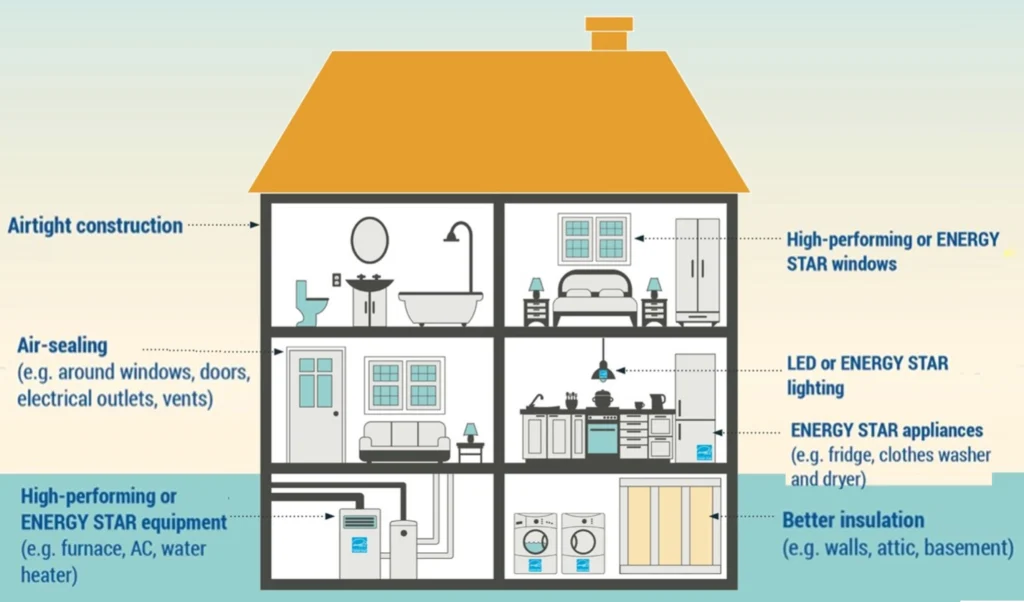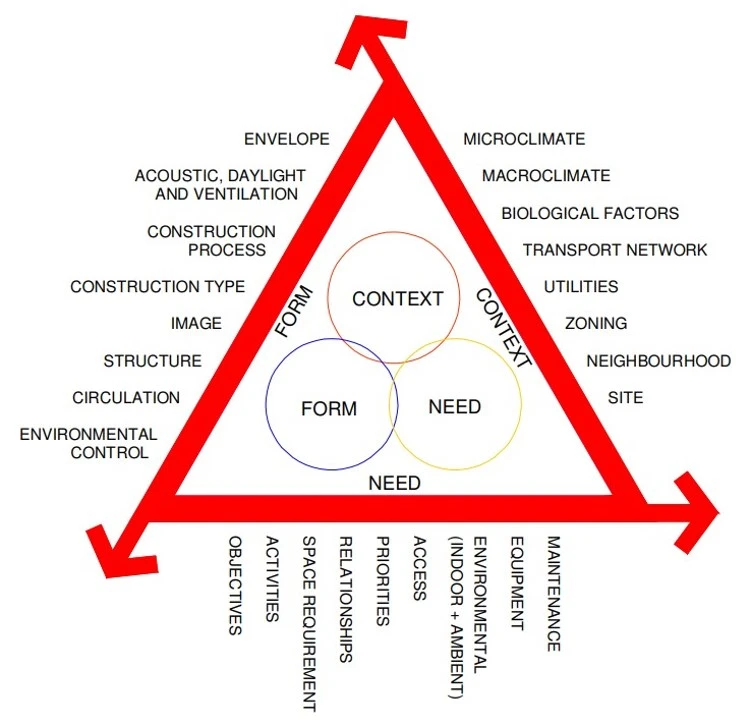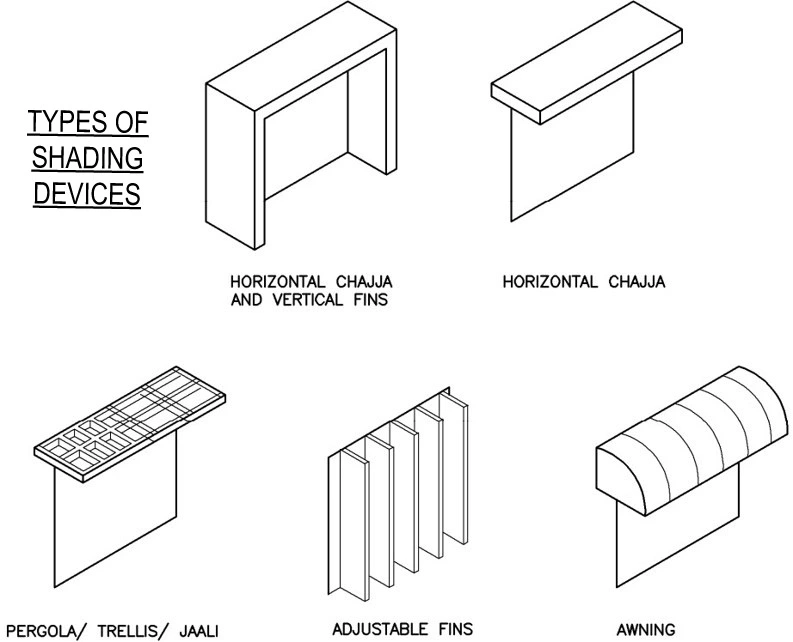Energy-efficient buildings are designed and constructed with the goal of minimizing energy usage while maintaining or improving the comfort and functionality of the space.

Key aspects include the use of advanced materials, innovative design strategies, integration of renewable energy sources, and the implementation of smart technologies.
These elements work together to create buildings that are not only environmentally friendly but also cost-effective and comfortable for occupants.
Relation of Energy & Buildings

- Buildings have High degree of interaction with its surroundings – Sun, Winds, Rains, Vegetation etc.
- Climatic Conditions Affect Building Comfort.
- Energy is required to make Buildings Comfortable.
- Building sector is high on energy consumption.
- A Building is a highly complex energy system.
Why is energy efficiency required in building?

- Buildings are responsible for more than 40 % of global energy use and 1/3 of global greenhouse gas emissions (GHG).
- Building Sector has the largest potential in reduction of greenhouse gas (GHG).
- Majority of emissions are from developed countries and cities.
- Rapidly industrializing developing countries will surpass emission levels from buildings in developed countries.
What is Energy Efficient Building
An energy-efficient building creates comfortable living conditions inside the dwelling with the least possible amount of energy consumption maximizing efficiency in use of resources.

It involves constructing or upgrading buildings that are able to get the most work out of the energy that is supplied to them by taking steps to reduce energy loss such as decreasing the loss of heat through the building envelope.
If you want to know about the Types of slabs or Permeable concrete or Islamic architecture, please click the link.
1) Advantages of an Energy Efficient Building

i) Environmental benefits
Energy-efficient buildings play a significant role in reducing the carbon footprint and mitigating climate change. By incorporating energy-saving technologies and sustainable materials, these buildings consume less energy for heating, cooling, lighting, and other operations.
This reduction in energy consumption leads to lower greenhouse gas emissions, which are a major contributor to global warming. For instance, utilizing high-performance insulation, energy-efficient windows, and renewable energy sources like solar panels can drastically cut down the amount of fossil fuels burned for energy.
Consequently, energy-efficient buildings help reduce air pollution and conserve natural resources, contributing to a healthier planet.
Key points
- Reduces Greenhouse Gas Emissions
- Lowers Carbon Footprint
- Reduces Air Pollution
ii) Economic benefits
The economic benefits of energy-efficient buildings are substantial and multifaceted. One of the most immediate advantages is the reduction in energy bills. By using less energy, building owners and occupants can save a significant amount of money on utility costs over time.
For example, energy-efficient HVAC systems, lighting, and appliances consume less electricity, leading to lower monthly expenses. Additionally, energy-efficient buildings often have higher property values. Buyers and renters are increasingly aware of the long-term cost savings and environmental benefits, making such properties more desirable in the market.
This demand can translate into higher resale values and rental incomes. Moreover, many governments offer financial incentives, such as tax credits and rebates, for constructing or upgrading to energy-efficient buildings, further enhancing their economic appeal.
Key points
- Reduces Energy Consumption
- Lowers Operating Costs
- Higher Rental & Capital Value
iii) Health and comfort benefits
Energy-efficient buildings provide superior indoor air quality and thermal comfort, contributing to the overall well-being of occupants. These buildings are designed to maintain consistent indoor temperatures, minimizing drafts and hot or cold spots.
High-quality insulation and energy-efficient windows help achieve this by reducing heat loss in the winter and heat gain in the summer. Additionally, energy-efficient buildings often incorporate advanced ventilation systems that ensure a steady supply of fresh air while filtering out pollutants, allergens, and moisture.
This results in a healthier indoor environment, reducing the risk of respiratory issues and other health problems. Enhanced thermal comfort and better air quality also improve occupant productivity and satisfaction, making energy-efficient buildings ideal for both residential and commercial purposes.
Key points
- Complies with Energy Performance Norms
- Creates New job opportunities
- Improves Corporate Image
What are the Areas of Energy Use in Buildings?

Parameters of architectural design for Energy Efficient Building

2) Make building energy efficient
i) Site
The environmental conditions experienced on the site are due to the macro climate as well as the microclimate. Site-specific conditions such as land form, vegetation, waterbodies, open spaces, etc. play an important role in building design.
Proper analysis of these conditions can enable one to choose a site and make suitable design plans. This would help save energy and also provide a fairly satisfactory indoor environment throughout the year.
ii) Building Envelope
A building interacts with the environment through its external façades such as walls, windows, projections, and roofs, referred to as the building envelope.
The envelope acts as a thermal shell, which if thoughtlessly constructed, would result in energy leaks through every component. Hence, each component needs to be properly chosen to ensure an energy efficient building.
Besides, an ideal orientation of the building at a site and proper building configuration play a significant role in the building’s performance.
iii) Orientation
Appropriate orientation of buildings can provide physically and psychologically comfortable conditions in the building. It can help exclude the undesirable effects of severe weather to a great extent.
For example, in cold climates, a building must be oriented to receive maximum solar radiation into the living areas for warmth on one hand, while keeping out the prevailing cold winds on the other.
Conversely, in hot regions, solar radiation and hot, dusty winds need to be avoided in summer, while cool winds must be admitted. Thus, appropriate orientation can control the amount of solar radiation and wind entering a building.
Once orientation is fixed, wind can be controlled by:
Tilting and projecting surfaces to deflect wind
Providing openings of appropriate size providing windbreakers to reduce wind speed
iv) Building configuration
Configuring the geometry of the building appropriate to the climate and usage can control the magnitude of the heat flow. For example, in an extremely cold climate, one needs to minimize heat loss from the building to the environment.
This can be achieved by:
- Using buffer spaces, e.g., sunspaces and balconies act as sit outs in favorable weather.
- Locating infrequently used spaces such as store rooms and toilets in the directions that face prevailing cold winds.
- Maximising exposure to solar radiation, e.g., major living rooms may be arranged facing the sun to gain heat.
- Locating habitable spaces appropriately, e.g., the most habitable spaces may be kept on leeward side to avoid cold winds. They may be clustered together to reduce exposure to cold.
v) Building configuration includes:
Surface area to volume ratio (S/V ratio)

The ratio of the surface area to the volume of the building (S/V ratio) determines the magnitude of the heat transfer in and out of the building.
The larger the S/V ratio, the greater the heat gain or loss for a given volume of space. Conversely, a smaller S/V ratio will result in the reduction of heat gain/loss.
Shape of the building:
Wind when obstructed by a building creates pressure differences, that is, positive pressure on the windward side and negative pressure on the leeward side.
Consequently, a new airflow pattern is established around the building. Thus, wind pattern across a building can be modified by shaping it appropriately.
Buffer spaces:
Buffer spaces such as courtyards, atria, balconies and verandahs provide shading and catch wind.
Arrangement of openings:
Appropriate openings connecting high and low pressure areas provide effective ventilation. Solid and glazed surfaces need to be suitably arranged and oriented for receiving or rejecting solar radiation.
Shading:
Shading of surfaces can be achieved by the self-shading profiles of buildings e.g. H-type or L-type as compared to the simple cube.

Shading devices such as chajjas block the solar radiation incident on the exposed surfaces of a building, consequently reducing heat gain.
vi) Building components
The nature of a building envelope determines the amount of radiation and wind that will enter the building. It consists of the following elements: Roof, Walls, Ground-based floor, Fenestrations, External colour and texture
- The heat flow through these elements is characterised by their resistance, thermal capacity, absorption, transmission and emission.
- The materials for these components have to be chosen carefully depending on specific requirements. The thermophysical parameters of materials that must be considered are specific heat, density and thermal conductivity.
- The heat gain through each element can be varied by: area of the element, orientation and tilt of the element, material properties (U-value, time lag, decrement factor, transmissivity, emissivity, etc), finishes, control of incoming solar radiation.
Roof
The roof of a building receives a significant amount of solar radiation. As per Indian Standard I.S. code 3792 – 1978, the maximum value of overall thermal transmittance (U-value) of a roof should not exceed 2.33 W/m2 -K in hot-dry, and warm and humid climates.
Insulating materials may be applied externally or internally to the roofs. In case of external application, the insulating material needs to be protected by waterproofing treatments. For internal application, the insulating material may be fixed by adhesive or by other means on the underside of the roofs.
Walls
- Walls constitute a major part of the building envelope and receive a large amount of direct radiation. Depending on whether the need is for heating or cooling, the thickness and material of the wall can be varied to control heat gain. The resistance to heat flow through the exposed walls may be increased in the following ways:
- The thickness of the wall may be increased, Cavity wall construction may be adopted, The wall maybe constructed out of suitable heat insulating material, provided structural requirements are met.
- Heat insulating material may be fixed on the inside or outside of the exposed wall. In the case of external application, overall waterproofing is essential.
- Light coloured whitewash or distemper may be applied on the exposed side of the wall. The I.S. code 3972-1978 specifies that the U-values of exposed walls should not exceed 2.56 W/m2 -K in hot and dry, and hot and humid regions. In warm and humid regions, they should not exceed 2.91 W/m2 -K.
Ground-based Floors
- Heat is transferred by conduction from the building to the ground through the floor which is in contact with the ground. The transfer of heat between the building and the ground occurs primarily via the perimeter of the building, and to a lesser extent through the central portion of the floor.
- In warmer climates, this heat loss is desirable from the point of view of comfort. On the other hand, in cold climates, heat loss through the ground needs to be minimised and hence insulation may be provided. The effectiveness of insulation under a floor will depend on factors such as the moisture content and temperatures of the ground.
- To improve performance, the entire slab should be insulated. Foundation insulation using foam board on the inside face of the foundation wall may also be provided. This protects both during construction and during the life of the building.
Fenestrations
- Fenestration is provided for the purposes of heat gain, daylighting and ventilation. Their pattern and configuration form an important aspect of building design. Appropriate design of openings and shading devices help to keep out sun and wind or allow them into the building. Ventilation lets in the fresh air and exhausts hot room air, resulting in cooling.
- The size, shape and orientation of the opening affect the speed and flow of air inside the building. For example, openings on opposite walls relieve high pressure on the windward side, permitting good cross-ventilation of the interior space.


External colour and texture
- The nature of the external surface finish determines the amount of heat absorbed or reflected by it.
- A smooth and light-coloured surface reflects more heat and light; a rough textured surface causes self-shading and increases the area for re-radiation.
- White or lighter shades have higher solar reflectivity and therefore are ideally used for reducing heat gain in warmer climates.
- Moreover, a heavy texture on these light-coloured surfaces helps to reduce the glare. Dark colours absorb more radiation, which increases heat gain through the surface, and can thus be used in cooler regions.